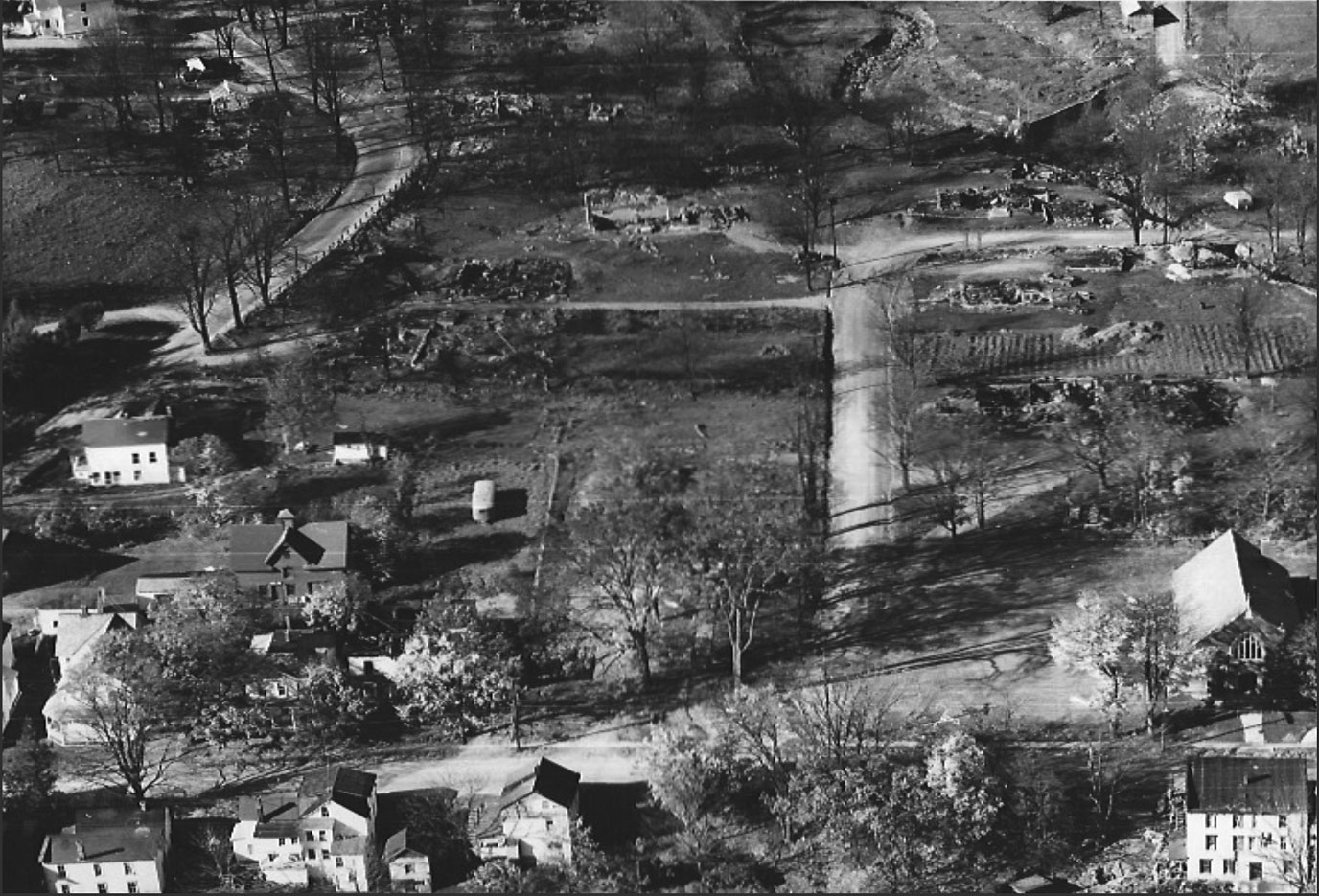Town Historian
July 4th Parades in Berlin
The date of the first Independence Day Parade in Berlin is lost in the mist of history, but we do know that the first one there is evidence of was in 1878.
A typical day would include a parade beginning at 9:30 am followed by a dinner at one of the churches or Community Hall. In the afternoon there would be a baseball game, or field day races. The Fire Department would frequently have a dance in the evening at the Fire Hall. Some years there would be fireworks in the evening behind the school.
Under the auspices of the Odd Fellows, the parade started at the old Elm tree (currently the location of Dollar General), and led through the main streets by Sheldon’s Cornet Band or the Odd Fellows Band. Houses would display red, white and blue decorations. Later starting places include Taylor Avenue in the W. J. Cowee yard, the First Baptist Church parking lot, and currently at the Berlin Elementary School.
The only part of the day that has survived is the parade that now starts at 11 am with the American Legion or Fire Company taking turns “stepping off” the parade. They are followed by the Grand Marshall, bands, floats, old cars, fire companies of Berlin and surrounding towns, horses, walkers and other conveyances the people wish to enter.
Thanks to a Parade Committee of volunteers who plan the parade that is now unique in Rensselaer County.

A float, circa 1911, on Main Street.
Soldiers Monument
Berlin, NY
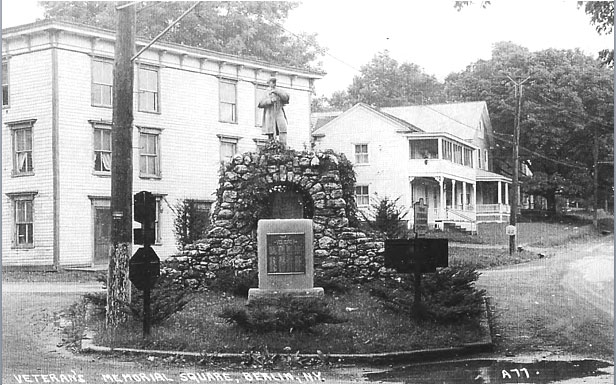
The Women’s Christian Temperance Union erected this monument in 1906. The Civil War soldier was added in 1909 when the GAR Post #511 and the Berlin Grange raised funds from folks around Rensselaer County to turn it into a memorial for all those in the county who served in the Civil War. After World War II the granite monument was added to honor those who served in World Wars I and II.
It stands on the corner of Plank Road and North Main Street (old Route 22) in the center of Berlin. At the left in the background is the home of world-famous harpist, Van Veachton Rogers.
Community Fairs in Berlin

Bentley’s Cave
It’s that time of year when spelunkers will soon begin exploring, and thanks to W. Robert Bentley and his daughter, Randi, the cave and about 5 ½ acres were donated to the Northeastern Cave Conservancy in 2009. The mission of the group is the conservation, study, and management of caves. (Actually there are two caves on the property; the other is much smaller.) The property is now known as Bentleys Cavern Preserve. There is a parking area and an informational kiosk showing a map and trail access. The Bentley Cave is a marble cave, unlike caves in Schoharie and Albany counties, which are limestone according to NCC President Bob Addis.
The cave has been owned by the Bentley family since 1769, when Col. Caleb Bentley, a Revolutionary War captain, settled on the property,
The cave has been the subject of several newspaper and magazine
articles and has been mentioned in many books about the area. Some of the stories may well be legends that have passed from one generation to the next.
The cave, reportedly the largest in Rensselaer County, is well concealed. One can pass by the entrance and not see it.
Col. Bentley learned of it when a burglary was discovered. It seems that the Taylor textile company in Berlin had several thousands of dollars worth of valuable cloth stolen. The burglary remained a mystery for many months until the cave opening was discovered along with evidence that the burglars had used it as a hideout. (Anon. 1935) The incident led to the popularity of the cave, especially by local residents.
Another claim is that captured Hessian soldiers escaped from their guards and hid in the cave.
Sometime between 1845-1855, Melancton Bentley leased the cave to some men from Troy claiming they wanted to get clay that was to be used to make paint. It was actually being used as a notorious gambling den! The men would come on Sundays and sometimes stay to the middle of the week swapping small fortunes in cards. The locals said these gamesters would remain in the cave all that time having brought food and drink with them. It was a long time before Melancton became suspicious of the men because of the actions of “Big Bill” (a Negro the gamblers hired to stand guard at the mouth of the cave, watching for the authorities or angry wives.) Well, as the tale goes, Big Bill became so proud of his position that he bragged about it, and one morning as the gamblers crawled out of the cave, and the sheriff met them with his posse and the gaming was broken up. (Perry 1946) In 1956 Perry, again writing about the legend, says the gamblers built a cabin near the cave entrance for the black guard, now called Pete. After the arrests, paint-clay mining took place with Pete as miner and perhaps salesman as well. The cabin was later burned and the ruins are gone.
There is some suggestion made in the 1950’s that Big Bill or Pete may have hidden fleeing Negroes in the cave as part of the Underground Railroad, but that has not been verified.
Newspaper reports also suggested that it was considered as a bomb shelter during World War II.
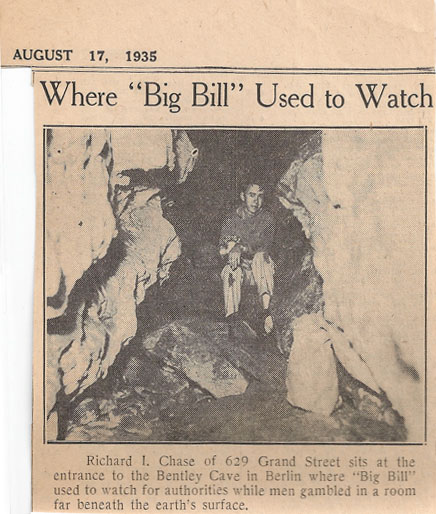
The Cave
(By Mildred Livingston Streeter)
There is an ancient cave upon yonder hill,
Its age quite unknown to man.
Perhaps it sheltered Indian tribes
Who passed upon the land.
It may have felt the wagon jolt,
As settlers came this way;
Or felt the stroke of a mighty axe,
As they worked hard by day.
It was a hideout for gamblers,
Rough they came;
Ending up there in the cave,
Fighting at their game.
Many generations
Have reached its depths or more,
To see the big room,
Or just to go explore.
For many times,
Have heard one say,
They could hear a wagon as they followed
Along the tunnel’s dark way.
Once a man being tired of life,
Hung himself, they say,
Up there by the cave,
They searched for him all day.
Mr. Siring, his name, they said;
Poor man, they found him dead.
It has sheltered many
From storms along they way,
And given cooling shade,
On the hottest summer day.
The Flood of 1891
During the summer of 1891 flash floods roared down each of the mountain streams emptying into the Little Hoosick River. The rain started early Thursday morning on August 27, and there was a steady downpour until noon followed by another heavy shower. The rain stopped for a while, and then at 7 pm there was a cloudburst with thunder and lightning. The flooding started about 8 pm. At that time it was the worst overflow of the Little Hoosick ever recorded—estimated at 20 to 30 feet above usual levels. Witnesses said it “took buildings away as though they were eggshells.”
Damage was estimated between $100,000 and $200,000—a lot of money at that time! Two people, Mrs. Thomas Taylor and James Smith drowned. Homes and farms were destroyed, gardens a total loss, the railroad was out of operation for three weeks, the course of the river changed, and the water pipe that fed the reservoir was washed away for 50 to 60 feet and 15 bridges were washed out.
The town board met to raise money to repair the damage to the highways. The Board authorized the supervisor to borrow $15,000 to help repair the highways and bridges. A footbridge was built across the Little Hoosick River for pedestrians.
It was said that had the flood occurred at a later hour (when residents were asleep) the loss of life would have been great.

Looking west toward Colonial Inn. Frey’s Ice-Cream Parlor is on the right (now gone).
Pictures below:
Upper Left: Corner of Main and Elm Streets as water rushes down the Plank Road
Upper Right: A view on the Plank Road
Lower Left: The Hammond Brook damage on Plank Road
Lower Right: The footbridge for pedestrians on Elm Street
Memorial Day Celebrations
The roots of Berlin’s Memorial Day Celebration began after the Civil War. Originally known as Decoration Day, it was established in May, 1868, by the Grand Army of the Republic (GAR) to strew flowers or otherwise decorate the graves of comrades who died in defense of their country during the Civil War. It was inspired by local observances of the day held in several towns throughout America that had taken place in the three years since the end of the War. Waterloo, New York, was declared as the birthplace of the event because the town had made it an annual, community-wide event in 1866 during which businesses closed and residents decorated the graves of soldiers with flags and flowers.
The Grand Army of the Republic (GAR) was an organization of former Union soldiers and sailors organized in 1866 to strengthen the bonds of comradeship, preserve the memory of fallen comrades and give aid to soldiers’ widows, orphans, and handicapped veterans, and most of all, to fight for pension increases and other benefits. Sometime between June of 1884 and 1885 Berlin veterans formed #511 Post Tappen (named after Silas Tappen), and by 1890 the organization had reached its peak.
In 1897, it was reported that Berlin celebrated Memorial Day with flags and bunting displayed in the streets and Post Tappen, Sons of Veterans, Odd Fellows, and Home Templars headed by Sheldon’s Band marched to the cemeteries and decorated the graves of veterans. A dinner at the First Baptist Church, with over 300 attending, was followed by a Memorial Service. In the afternoon there were various races and a ball game between a team from Williamstown and the home nine which Berlin won 16-1!
Memorial services were often held in various churches of Berlin after decorating the graves and other activities. Some years the school children carrying the flowers and, headed by the band, marched to the Seventh Day Cemetery where local ministers said prayers and a flag and floral tribute was placed upon the grave of each soldier. After these exercises, teams of horses and wagons would carry the old veterans to the Center Berlin Cemetery to decorate the graves.
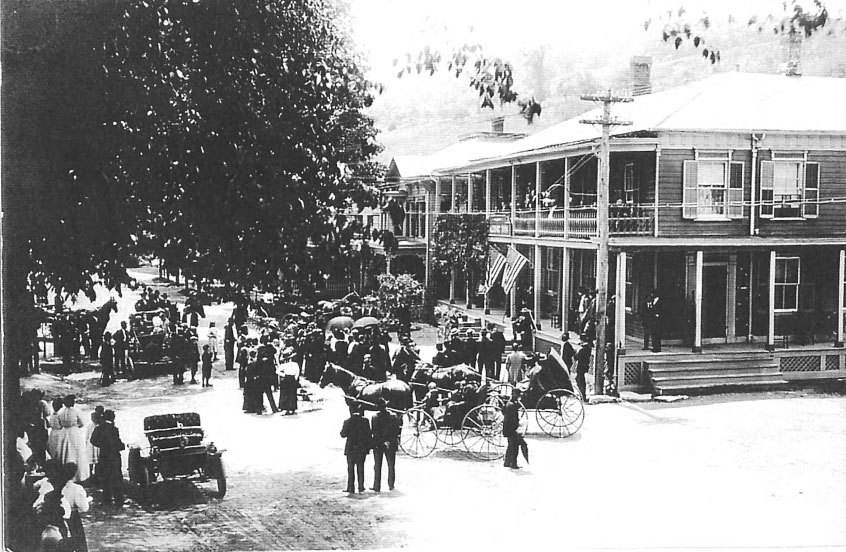
The Taconic Inn in 1912 as the crowd begins to gather for Memorial Day.
By 1912, as shown in the photograph, the procession was returning to the Taconic Inn (better known to us as the Colonial Inn) on Main Street where a memorial address and prayer were offered to the large audience standing in the street. Howard Tracy read Lincoln’s illustrious Gettysburg Address and Rev. Roberts of the Methodist Church gave an “eloquent patriotic address” in the morning. The newspaper clipping from that event goes on, “The roll of names lessens yearly and before many years have passed the last remaining veteran will have gone over to the eternal camping grounds. Berlin’s Roll of Honor—Alfred E. Tracey, James E. Winn, Leonard L. Lewis, Stephen B. Chapman, Jet N. Stillman, George Grant, Frank U. Brown, Morris Broderick, Fritz Mulson, Charles Busher, Ira Grant, Lester L. Cowdry, Samuel Bentley, Amzi Hill, Hiram Main, John Loker, Edward Rhodes, and W. E. Hull.

Members of the G.A.R. in 1910 are front (l. to r.) Leonard Lewis, Will Hull, Ed Winn, George Grant, Charlie Busher, Henry Lott; back: (Standing) Morris Broderick (holding flag), Jet Stillman, Sylvester Cowdry, Eleazor Reynolds, Alfred Tracy, William R. Lewis, Edward Boesse, Amus Hill, Israel A. Mason, Edward Rhodes. The picture was taken in front of the shed which was behind the First Baptist Church.
The last encampment of the GAR was 1949 and the last member of the national organization died in 1956.
The celebration took place across the country on May 30 of each year until 1971 when most states changed to a newly established federal schedule of holiday observance.
The American Legion Post #937 in Berlin has carried on the tradition of this parade. The parade is composed of veterans of our wars, the school band, and other organizations marching to the monument in the center of town where there are prayers and a short speech. A floral wreath is placed at the monument which honors Berlin veterans of all wars. The parade then continues on to the Seventh Day Baptist Cemetery where there is a gun salute and taps is played. Veteran’s graves in both Berlin cemeteries are adorned with flags placed there by members of the Legion.
I, for one, am grateful that this tradition of long standing honoring those who have fought to keep us free continues to exist.
The History of Berlin Highways
We think the roads are bad today, but they are much improved since Berlin became a town.
Two hundred years ago our valley as compared to today was an unbroken wilderness. The pioneers came here with their worldly possessions in an oxcart and the dream of a better life. Over a period of
time, farmhouses and hamlets were developed and took the place of the thick forest through the industry, frugality, and perseverance of those first settlers. As settlement of the Taconic Valley
increased, highways were opened to the towns in the valley. These roads show us where people wanted to go and why. Destinations might be a gristmill, a tavern, a fort, etc.
Early travel was slow going and rough. The roads were bumpy, full of holes, and rough. When it rained, the roads were muddy and when it didn’t, they were dusty. In the winter they were snowy, but at
least the snow filled the holes! Most travel on snow was by sleigh—a pod (pulled by one horse) or a pung (pulled by two horses)—which had wooden runners and went easily over the snow.
It is said the road from Stephentown to Petersburgh, passing north and south through our town, is the oldest existing highway in Berlin. It was first an Indian trail. These trails were so narrow that
people were forced to walk single file. Later, the trail became a settlers’ path through the wilderness and finally a public highway that was called the Hoosick Road. Today we know it as Route 22.
The “Albany Road” is shown on the Bleecker Map of 1767. It eventually ran east and west from Albany through Berlin via Stage Coach Road and Green Hollow to Willliamstown and later on to Boston; it
was known, for a time, as the Eastern Turnpike. (Thus, the historical marker on the corner of Route 22 and Elm Street.) George Washington is understood to have made several trips between Albany and
Boston on this old road. So, although George Washington didn’t sleep here, it seems he went through Berlin when the valley was known as “Little Hoosick”.
Turnpike rates were as follows:
- vehicle drawn by 1 animal—3/4 cent a mile; the more animals, the higher the rate.
- score of sheep or swine—1/2 cent a mile
- score of cattle—1 cent a mile
- horse and rider or led horse—1.2 cent a mile
Some persons were exempt from tolls:
- those going to church, to or from a blacksmith, to or from a gristmill for family use
- those going to or from a midwife or physician, to or from court when legally summoned, to or from militia training, or a town meeting or election.
Then there were those who would go around the tollgate to avoid the charge. These paths around the tollgates were known as “shunpikes”.
The winding road over the mountain from the center of Berlin to Poestenkill and Troy was first known as the Old Petersburgh Road (what we call the Plank Road today). During the first years of settlement here, it was simply a narrow trail wide enough for ox-carts. As horse-drawn vehicles came into more general use, a stagecoach service was established between Berlin and Troy. The road was widened and paved with wooden planks. Known as the Berlin-Poestenkill Turnpike, it opened in in 1833 with tollbooths along the route. One could buy shares for $20 each from the company who built it. John Reeve (our first town supervisor) and Hezekiah Hull were commissioners from whom you could purchase stock. Burton Hammond, Edward Whitford and Winter Greene (all of whom were Berlin supervisors at one time) were appointed commissioners to lay out the road. By 1836 this road made of planks extended to Troy. The proceeds of the tollgates were used to keep the road in good repair and give investors a return on their investment.
In 1894 H. J. Hull ran the stage between Berlin and Troy. Later Charles Judevine, Adnah Jones, and Alonzo Breer would make the trip over the mountain as the stage operators.
The stagecoach would leave the landing stage behind the Colonial Inn in the morning and return from Troy the next day.
All these roads have changed course, perhaps more than once over the years. Bridges have been built, curves have been taken out in some places, and houses have been taken down to make wider roads for the accommodation of newer modes of transportation.
The highway superintendent was known as the “pathmaster” when these roads were first built and improved, and there was a “labor system” to pay the road taxes. Each male property owner spent time working on the road equivalent to his property value. It was not until 1906 that Berlin went to a “money system”. The June vote in Berlin passed—162 in favor and 76 against. Under this system, the state provided that for every dollar raised by the town for road taxes, the state would reimburse the town 50 cents. Thus, if $1,000 was raised by the town, the state would pay the town $500.
The widespread improvement in living conditions, trade, and travel encouraged others to settle in Berlin, and by 1810 the population was 3,012! The advent of other modes of transportation, such as the Erie Canal, along with other reasons, would beckon some of these early settlers of Berlin to move farther west making our population decline.

The Berlin Train Station
When we think of the railroad which ran through our town, we often think of the school children that rode the train to Berlin from Stephentown and Petersburgh (as seen above). You may also know that
there was a milk train, a mail train, and a freight train.
Many do not realize that the train also took our Berlin baseball team to the towns of our rivals, and a crowd would greet the returning team, or that one could go to New York City (as A. C. Niles did to
stock his general store on Main Street), or points north as far as Rutland, Vermont. By changing trains in North Petersburgh, one could go to Troy or other places. The Berlin station was “the most important
and profitable station between Chatham and Bennington” according to a Rutland Railroad historian.
By 1900, the Rutland Railroad was leasing The Chatham and Lebanon Valley Railroad. A pamphlet of that year has a list of hotels, farmhouses and cottages and villas taking summer boarders. Many folks came
to Berlin on vacation during the summer to breathe the fresh, clean air, behold the beautiful scenery, see the gladiola fields, fish, visit friends, or just relax.
No fewer than 41 listings for boarders are under South Berlin (now Cherry Plain), Center Berlin, and Berlin! Among those who took summer boarders from Cherry Plain were three Mattison families and Mrs.
Elmer Burdick; from Center Berlin, Mrs. H. D. Tanner; and from Berlin, H. F. Brown (Jane Fitzgerald’s home), J. Dennison, The Berlin Hotel, W. H. Lewis, Mrs. A. E. Sands, Mrs. J. A. Rasico, Mrs. J. W.
Stillman, C. E. Jones, Adnah Jones, and A. C. Niles.
The price of a room varied between $4 and $10 a week while the Berlin Hotel charged between $1 and $2 a day and had accommodations for 40. Most private homes could accommodate between 2 and 6 boarders.
Most of the places taking summer boarders were listed as less than a quarter mile from the station.
In 1901 the Rutland Railroad purchased the Chatham and Lebanon Valley Railroad, which it had been renting, and continued to run trains through Berlin until 1953. Did you go on the last excursion to Rutland
that year? It was sad to see the railroad go for it had certainly contributed to Berlin being the most progressive community in the valley. It was with the help of the railroad that Berlin came into its
own at the turn of the last century. W. J. Cowee, Inc., was in its infancy; Arthur Cowee was growing and popularizing the gladiola. Talk was underway to start a fire company, which became a reality in
1904. The Frary Spool Company, Satterlee’s Cheese Factory, the Taconic Valley Bank, the Old Fellows Lodge, the Berlin Electric, Light, Heat and Power Company, and the Water Company, as well as an accredited
high school would all be in place during the first decade of the last century.
The railroad provided businesses with an inexpensive way to ship their products helping their businesses grow, and many individuals were employed. Arthur Cowee built his bulb house across from the station
for easy access to shipping his bulbs around the world. (That building later became the Community Hall and eventually the Fire Hall. Cottage industries also sprang up and many benefited from being able
to rent rooms to summer boarders making Berlin a prosperous community.
Later, Ted and Tommie Cowee donated the building to be used by the Boy Scouts and Camp Fire Girls to have a meeting place. The building then became known as the Watipi building. (The name was chosen because
it is an Indian word meaning “Meeting place”.) The ideals of those organizations certainly had an influence on the youth of our community that led to volunteerism and many other attributes we look for
in the members of our community.
Both the Cherry Plain and Center Berlin are long gone. From a historian’s point of view, it would be a shame to lose this building which meant so much to the growth and development of our town. We can
certainly still use “meeting places.”
Note: To learn more about it, read Memories of Berlin by Katherine Wells.
Fifty Years Ago—Disaster
From the time Berlin was established as a town in 1806, we have had our share of disasters and tragedies. From epidemics, blizzards, fires, and floods to tornadoes, accidents, and draughts, nothing
in modern times has equaled the propane truck disaster, which occurred 50 years ago on July 25, 1962.
Nine people died of burns, one of whom was Robert J. Lucas of Pennsylvania, driver of the 7,000 gallon tanker loaded with propane that left the Plank Road at a sharp turn, hit a tree and exploded leaving
the area looking like a war zone.
Experts who investigated the accident said the propane spewed from the ruptured tank, mixed with air, and formed a cloud that spread rapidly over the area, and then exploded.
If you were in Berlin on that day, it is something you will never forget and something you don’t want to talk about very much. Initially, no one knew what had happened except that it was bad!
Eleven homes and the First Baptist Church burned to the ground. Sheds and barns and garages were razed. Cars and school buses were destroyed and other houses were badly damaged.
Worse still was the loss of human life—our friends and neighbors. On that fateful day we lost Mrs. Rosalie Loker, Mrs. Victoria Loker, Joseph E. Sourdiffe and his wife, Kenneth McCumber and his wife
Florence (“Flossie”), Mary Brazie, and Dorothy Wager. Some add Mabel H. Wager to the list as she died in her sleep that night of a heart attack. And, of course, there was the driver of the truck, Robert
Lucas. Several others were badly burned.
Not all died immediately; it seemed like each day another wake and/or funeral was added to the list.
It had been a dry summer, which meant the water supply was limited, and the major fire spread rapidly before any apparatus could respond. That meant the principal job of the fire companies was to confine
the fire to the area and effect whatever rescues could be made.
No longer can spectators be in the area, hampering the firemen and ambulance folks, as it was that day. Some fires even popped up again the next day.
In the following days, thousands of people visited the site. Some local folks were upset feeling the town was like a sideshow. However, many put money in milk cans near the area to help victims and
families. Others sent money by mail; all told, more than $20,000 was collected in this manner according to then supervisor, W. Robert Bentley.
We must be grateful that the new Route 22 had been completed a short time before, enabling fire companies and ambulances to get to the scene more quickly. Fire apparatus and ambulances from 13 communities
in Rensselaer County and from Dalton and North Adams, Massachusetts, were called upon thanks to the Mutual Aid Response in place at the time. It was reported that traffic was backed up for 7 miles!
We must also be grateful that the propane truck didn’t travel another 30 seconds downhill before the accident for it would have involved the center of town where hundreds of people were in residential
buildings, businesses, and the hotel.
As a result of this tragedy, State Police, the Sheriff’s Department, ambulances and fire companies now work together even better than they did then.
It was determined that the cargo tank had a faulty weld causing the explosion. Since then tanks have been redesigned which may well have aided the outcome of the recent propane truck accident in Hoosick.
The area of greatest impact has been rebuilt and is hardly discernable now, except to those of us who were here on that day. However, the scars of the families of those whose lives were cut short will
always remain.
The Berlin Dutch Settlement Church
The Dutch Settlement on West Mountain began with two families—the Gutermuths and the Jordans—decided to come to this country. (The “Americanized names became Goodermote and Yerdon.) They were tired of their men being killed in countless wars, and having their fields plundered by invading armies,. Those who made and sold charcoal for their living, saw their forests burned by enemies. These people of Bavaria were simple, hard-working, clean-living Germans, who set sail in January 1834. After 80 days at sea, they arrived in New York City where they were met by other families who had come here earlier. The German families who met them were from the Capital District area. They brought the newcomers to Glass Lake in the town of Sand Lake.
Primarily because of their desire to keep to themselves and to keep their social standards and customs intact, they moved to the high plateau between Berlin and Sand Lake.
Soon they wrote back to Bavaria telling friends of this new country and others came.
These new families included the Willibrants, Teals, and Schilzhowers. They were a closely-knit group and married within their own community. The community grew and so did the charcoal business.
It was not until July of 1862—150 years ago—that they were able to worship in their own church.
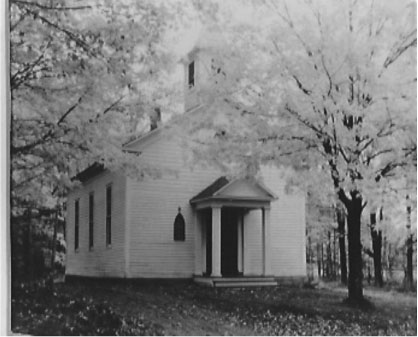
One of the money-raising events held each year was the Dutch Picnic which some still remember. Folks from Berlin, Stephentown, Taborton, and Sand Lake attended. There was plenty of delicious food, grab bags for the youngsters, Bingo, and round and square dancing enjoyed by young and old alike.
In 1934, the Gutermuth and Jordan Memorial Stone was dedicated and still stands on the corner of Dutch Church and Taborton Road.
Unfortunately, the church did not survive. Fire damaged the rear portion of the church in 1967, but it was quickly repaired. Then in October, 1968, the building was completely destroyed by fire. It was decided that it should be rebuilt in identical form to the original. Construction was started on November 5, 1968, but was halted by winter snows. A. J. Goodermote and Sons of Berlin had the new church completed in the spring of 1969. Insurance covered the entire cost of rebuilding, and interior furnishings were all donated primarily by other churches.
Services were still being held every other Sunday afternoon during the summer months.
The church was again completely destroyed in 1982, and a memorial stone was placed on the site. The feeling was that being so isolated, the chance of another arsonist doing a dirty deed might well strike again.
There will be a 150-year celebration this July. Watch the local papers for more information.
Did You Know?
In 1934 a 26-foot Christmas tree, a gift from New York State to President Franklin Roosevelt, was set up in the White House. New York foresters picked the finest balsam that could be found in the state's game refuge (now Cherry Plain State Park) at Cherry Plain. The tree was taken to Berlin, wrapped and loaded into an express car for the trip to Washington.
A 25-foot balsam Christmas tree was also sent to the White House in 1944 . The tree reportedly weighed close to 200 pounds and was too large for an express car, so it went via the Rutland Railroad to Troy's Union Station where it was transferred to a Delaware and Hudson train headed for Washington, D. C.
This was the 14th tree cut by Leo King, caretaker of the Cherry Plain State Game Refuge in the Town of Berlin, for Mr. Roosevelt who first received the Conservation Department's present when he was New York's Governor. A twin tree was to be sent to Governor Dewey.
XXXXX
A Monster in Berlin?
The Troy Daily Budget, in its Local Summary Column, printed the following on April 14, 1852:
"An Awful Monster.--We saw this morning the dead body of one of the most singular natural curiosities which we have ever beheld. It was what preported to be the carcass of a calf--resembling in its conformations to anything but a wolf. The head--which measured in circumference, just above the ears, 3 feet and 3 inches--have a striking and startling resemblance to the human head. From above the eyes to the back of the neck it presented itself a perfect resemblance to the head of an old man--the hair and locks being of the "silver gray" order--and the whole bearing an exact resemblance of what an old man's head would be were it enlarged into Brobdignagian (giant) proportions. The forehead was singularly perfect, giving a striking develpment of what the phrenologists (those who study the shape, etc. of the skull) call the "reflective faculties." The under jaw was similar to that of a hog--being furnished with tusks and other swinish appurtenances. The eyes were large and remarkable in appearance, with eyebrows somewhat resembling those of an old man. But the body was no less remarkable than the head. The monster was of no sex--and possessed the feet of a hog--the tail of a dog--and a body covered with hair like that of a grey-hound. Thus this remarkable curiosity has in combination some portions of the human, the hog, the cow and the dog species.
It is the property of Elisha Hull, of Berlin, who has brought it to this city to show it to those curious in such matters. It may be seen at Worden's Hotel, Congress Street.
Elisha Hull was born in 1795 in Westerly, Rhode Island, and died August 3, 1868. His parents were Thomas Hull and Amy Peckham. Elisha was a descendent of Daniel Hull who made the first Yankee settlement in Berlin in 1770. One can read more about the Hull family in "Reminiscences in the Settling of the Valley of the Little Hoosick" by Nelson Hull written in 1858.

Ice Harvesting
Having an "old fashioned" winter this year brings to mind ice harvesting! Youngsters today probably don't know what an icebox is! Many who grew up with them called their new electric refrigerators "iceboxes".
How often do we think about how difficult it must have been just to preserve food a hundred years ago? Some families had root cellars while others had spring houses. Until about 1800 Americans were content to cool their food and drink in this manner.
From about 1800 until 1920 nearly every community of any size in the northeastern United States had its local ice harvesters since people wanted something better than dried or salted meats, and that included Berlin.
Initially, axes were used to chop ice from ponds and later the ice saw was used. Experienced ice harvesters preferred small, deep lakes away from towns where the water was pure. The clearer the ice, the denser the cakes and thus more lasting. Ice formed on top of mountains is said to be the hardest and the slowest to melt. Thus, Kendall Pond, Dyken Pond, and the reservoir were ideal places for good ice. I am told that ice was also harvested from the pond on the Bentley Farm. That pond, which was approximately in front of the home of Stanton Goodermote, no longer exists.
The thickness of the ice at Kendall and Dyken Ponds was given in the weekly newspaper, and was reportedly of a "fine quality" or "clear as crystal". One such newspaper entry in February, 1909, stated that "most of the ice houses about the village were filled last week. Some with the 15-inch lake ice, so clear that you could tell the date on a half dollar through it."
Mike Oswalt and Walt Nichols drew ice and A. J. Goodermote kept his men busy in the winter drawing ice from Kendall Pond and the reservoir. He once lost a team of horses through the ice at Kendall Pond, but managed to get them out. Imagine the job that was! Gib Yerton, one of A. J.'s men, built a cutter with saws and a ramp to the sleigh to haul the ice more easily.
The harvesters eagerly awaited the date when the ice could support a team of horses. After the holes were bored in the ice and measuring rods inserted to check the thickness, the harvester removed the snow from the ice. The harvester usually sought ice that was 14 to 16 inches thick, but some years had to settle for it being only 8 to 12 inches thick.
The harvesting of ice was usually done in a few weeks, and the men had to work rapidly because the supply depended solely on the climatic conditions. In Berlin, most harvesting was done sometime in late January through February, depending on the weather.
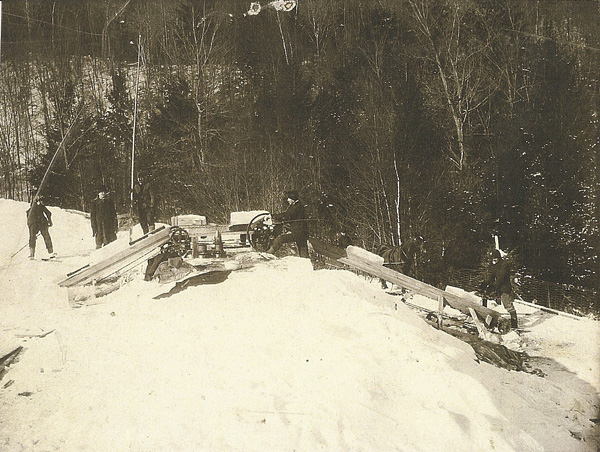
In March of 1900, the Water Supply Company, under the direction of Tracy D. Taylor, had cut and furnished nearly all the fine twelve-inch ice stored in the village and vicinity. The reservoir had been enlarged the previous year enabling the harvesting of all the pure spring water ice that was needed. Several farmers had ice houses as did the engine house of the railroad.
There was an ice house at Wyckoff's (across the road from the home of Ed and June Schindler), and one at the home of Dave Sicko used by Mr. Whitney for the Ranch Tavern. Manchester's Market, Stillman Brothers Store, and the condensary also had ice houses. There was also a small one on the corner of Main and Elm Streets on the site of the shirt factory which was used by J. Wilcox (a soda maker).
Different reasons for building ice houses were given: better quality meat, cooler milk, sweet butter, and the preservation of food as well as the slaughtering of animals in warm weather without the fear of spoilage. For an average farm family, an ice house 10 by 10 feet was adequate. Ice houses were located in areas divested of trees, and exposed to a free circulation of air.
When possible, the ice houses were painted white to help reflect the sun so the ice didn't melt as fast. It was the usual custom to have a layer of sand about 10 inches deep on the bottom of the ice house, covered with a layer of straw. And, of course, there had to be a drain in the bottom to carry off the watere.
The floor was made of three to six-inch planks, high enough from the ground to allow free circulation of air and slanting enough to drain the water. The cost of building an ice house in 1840 was about $20; by 1870 the cost had gone up to $150.
As ice was brought into the ice house, many farmers threw a layer of sawdust on top of each row of cakes for insulation. When ready to use the ice, the sawdust would have to be washed off thoroughly.
I'll take my frost-free refrigerator, thank you very much!
During President's Week this past February, one of the TV channels ran a story about Samuel J. Tildon who was born in New Lebanon, just down the road from Berlin. He served as the governor of New York State which propelled him into being the Democratic candidate for President of the United States in 1876.
Tilden won the popular vote but the result in the Electoral College was in question because three southern states sent two set of Electoral Votes to the Congress. So, Congressional leaders tried to resolve the crisis by creating an Electoral Commission that would determine which set of votes for those three states was valid.
This Commission consisted of five members from the Republican-controlled Senate (3 Republicans and 2 Democrats), and five from the Democratic-controlled House of Representatives (3 Democrats and 2 Republicans). The remaining five members were chosen from the Supreme Court consisting of 3 Republicans and 2 Democrats.
Everyone voted along party lines, giving Tilden's opponent became President.
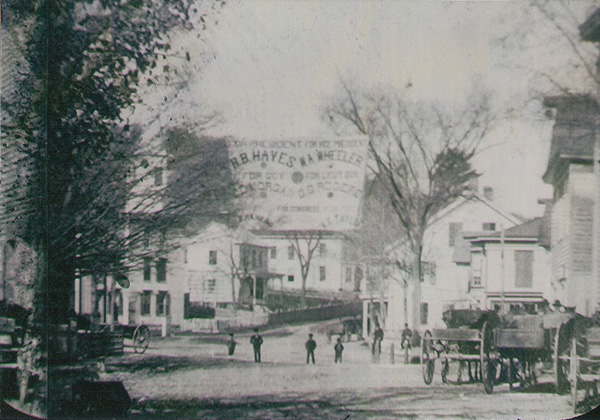
The banner on Main Street in Berlin shows the town to be behind the Republican candidate!
Did You Know?
An early settler in Berlin was the grandmother of one of the Presidents of the United States?
One of the early settlers in Berlin was Robert Austin who, in 1774, yoked his oxen, put them to his cart, and loaded on his few household belongings in Rhode Island and headed to the "far west" to seek his fortune. His sister, Amanda, made the 21-day journey with him. They made their way up the steep and rocky mountainside, over the peak, passed Kendall Pond and found a level plot of ground and here there ended their journey. This was in the area of Yerton's old sawmill and across the road from Sally Smith's home.
After the close of the war, his wheat had increased so he could have it floured. There was no mill closer than Hoosick, where on one of his trips there, the lady where he was staying told him that she wished she could have a servant girl. Robert said perhaps his sister would come and be her servant.
A few days later, Amanda was in the lady's service. As time passed, Miss Austin made the acquaintance of Roger Birchard. Soon after they were married and moved to his home in Brattleboro, Vermont. Roger and Amanda had a daughter by the name of Sophia who married Rutherford Hayes. Their son was Rutherford Birchard Hayes, the man elected President of the United States in 1876!
As in the year 2000, this election was controversial. Hayes's opponent, Samuel J. Tilden (from New Lebanon, New York) won the popular vote and led the electoral college, but the returns in several states were in dispute. Remember Florida? A special electoral commission convened and handed the presidency to Hayes. Thus, the two candidates in the election of 1876 had roots within 20 miles of each other!
As chief executive, Hayes's accomplishments were mixed. His conservative financial policies helped to lift the country's economic depression, and he was able to reform the civil service and quell the 1877 labor uprising. It was his ability to compromise in order to help revitalize a floundering and factionalized nation that serves as his legacy.
He chose not to run for re-election.


